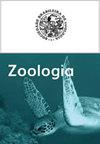塞拉多森林碎片中盔侏儒兽的白细胞谱
IF 1.8
4区 生物学
Q4 ZOOLOGY
引用次数: 1
摘要
白细胞数量和比例的变化,被称为白细胞谱,已经被记录在几种鸟类身上,并被用来测量这些动物的压力水平。本研究确定了影响盔侏儒兽Antilophia galeata (Lichtenstein, 1823)白细胞分布的生物学和生态学特性。这个物种在生态学研究中被认为是有用的,因为它对环境变化有反应。从塞拉多森林片段中捕获的89只galeata个体的血液样本在光学显微镜下进行了分析,以鉴定和量化白细胞和微核。淋巴细胞数量在雄性、非生殖个体和蜱感染个体中较大。白细胞成分与年龄、蜕皮或身体状况指数均无差异。微核数量与白细胞总数、H/L比值、嗜中性粒细胞、嗜碱性粒细胞和单核细胞值相关。结果表明,繁殖可能是该物种的免疫抑制因素,导致淋巴细胞利用率的性别差异。此外,基因毒性损伤的生物标志物(微核)与白细胞的数量有关,表明个体可能对环境干扰敏感。白细胞谱可以被认为是解决与退化环境中物种保护有关的生态问题的有用工具。本文章由计算机程序翻译,如有差异,请以英文原文为准。
Leukocyte profile of the helmeted manakin, Antilophia galeata (Passeriformes: Pipridae) in a Cerrado forest fragment
Changes in the amounts and proportions of leukocytes, known as leucocyte profiles, have been documented for several bird species and have been used to measure stress levels in these animals. The present work ascertained the biological and ecological attributes that influence the leukocyte profile of Antilophia galeata (Lichtenstein, 1823), the helmeted manakin. This species has been deemed useful in ecological studies because it responds to environmental changes. Blood samples drawn from 89 individuals of A. galeata captured in a Cerrado forest fragment were subjected to analysis under optical microscopy to identify and quantify leukocytes and micronuclei. The number of lymphocytes was greater for males, non-reproductive individuals and individuals infected with ticks. None of the leukocyte components differed in relation to age, molting or body condition index. The amount of micronuclei was correlated with values for total leukocytes, H/L ratio, heterophils, basophils and monocytes. The results suggest that reproduction may be an immunosuppressive factor for the species, producing sexual differences in lymphocyte availability. In addition, biomarkers of genotoxic damage (micronuclei) were related to the amount of leukocytes, indicating that individuals may be sensitive to environmental disturbances. Leukocyte profiles can be considered a useful tool for addressing ecological questions that are relevant to the conservation of species in degraded environments.
求助全文
通过发布文献求助,成功后即可免费获取论文全文。
去求助
来源期刊

Zoologia
生物-动物学
自引率
0.00%
发文量
15
期刊介绍:
Zoologia, the scientific journal of the Sociedade Brasileira de Zoologia (SBZ), is an international peer-reviewed, open-access Zoological journal that publishes original research on systematics, evolution, taxonomy, nomenclature, biogeography, morphology, physiology, biology, ecology, symbiosis, conservation, behavior, genetics and allied fields. The journal, formerly known as Revista Brasileira de Zoologia, publishes original articles authored by both members and non-members of the Society. The manuscripts should be written exclusively in English.
 求助内容:
求助内容: 应助结果提醒方式:
应助结果提醒方式:


